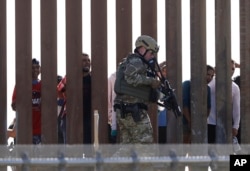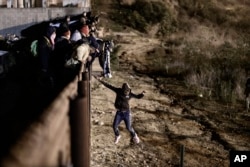U.S. counterterrorism officials are sticking by their assessment that terror groups like Islamic State and al-Qaida are not actively trying to sneak operatives into the country from Mexico, despite claims by the White House and Homeland Security officials that "the threat is real."
"We do not see any evidence that ISIS or other Sunni terrorist groups are trying to infiltrate the southern U.S. border," a senior counterterrorism official first told VOA in November, while acknowledging the existence of "vulnerabilities at both our northern and southern borders."
Contacted again ahead of President Donald Trump's prime-time television address Tuesday on what the White House has repeatedly described as a "crisis" at the southern border, officials said there was no new information to cause their assessment to be updated.
The assessment would appear to leave U.S. counterterror officials at odds with both the White House and the Department of Homeland Security, which have repeatedly emphasized the danger from suspected terrorists in recent days as the administration has been trying to make the case for building a wall along the border with Mexico.
"The threat is real. The number of terror-watchlisted encountered at our Southern border has increased over the last two years," Homeland Security Secretary Kirstjen Nielsen wrote late Monday, the first in a series of tweets on the subject.
"The exact number is sensitive, and details about these cases are extremely sensitive," she added.
Department of Homeland Security officials have repeatedly said that they stop, on average, about 10 people on the terror watchlist from entering the United State on any given day, and more than 3,700 for Fiscal Year 2017.
According to DHS, "Most of these individuals are trying to enter the U.S. by air, but we must also be focused on stopping those who try to get in by land."
But data from U.S. Customs and Border Protection (CBP), and first reported by NBC News, indicates that the numbers appear to be low.
From Oct. 1, 2017, through March 31, 2018, CBP said it encountered 41 people at ports of entry along the U.S.-Mexico border who were on the U.S. terror watchlist. All but six were either U.S. citizens or lawful permanent residents.
In comparison, CBP encountered 91 people on the watchlist along the northern border with Canada, including 41 who were not American citizens or legal residents.
But Homeland Security officials insist the threat is larger, pointing to encounters along the southern border with more than 3,000 so-called "special interest aliens" — described as individuals "employing travel patterns known or evaluated to possibly have a nexus to terrorism."
State Department officials Tuesday defended DHS's assessment of the danger.
"Transnational terrorists in the Western Hemisphere pose an immediate threat to Americans," State Department Deputy Spokesman Robert Palladino wrote on Twitter.
"ISIS, al-Qaida, and Lebanese Hizballah operate wherever they can find recruits, raise support, operate unchecked & pursue their terrorist agendas," he added. "Our southern border remains vulnerable to potential terrorist transit."
U.S. intelligence officials have long warned Hezbollah, a Shia terror group backed by Iran, has operatives in Central and South America connected to the trade of illegal drugs and weapons.
And while cautioning there is no evidence to support concerns Islamic State or al-Qaida were trying to get into the U.S. from Mexico, the U.S. counterterrorism assessment on the southern border does not rule out potential threats from Hezbollah or Iran.
But if the concern is about Hezbollah or other Shia terrorist groups, officials are not saying. DHS has not responded to questions about the nature of the threat posed by Iranian-linked groups. The State Department referred VOA back to DHS, but also pointed to its 2017 Country Reports on Terrorism.
"At year's end there was no credible evidence indicating that international terrorist groups have established bases in Mexico, worked with Mexican drug cartels, or sent operatives via Mexico into the United States," the report stated.
"The U.S. southern border remains vulnerable to potential terrorist transit, although terrorist groups likely seek other means of trying to enter the United States," it added.
Meanwhile, some former officials though, argue that the White House and Department of Homeland Security are exaggerating the nature of the terror threat along the southern U.S. border for political gain.
"No such crisis exists," Nicholas Rasmussen, the former director of the National Counterterrorism Center (NCTC) wrote Tuesday for the online forum Just Security.
"There is no wave of terrorist operatives waiting to cross overland into the United States. It simply isn't true," wrote Rasmussen, who led NCTC from December 2014 until December 2017.
"Anyone in authority using this argument to bolster support for building the wall or any other physical barrier along the southern border is most likely guilty of fear mongering and willfully misleading the American people."
















